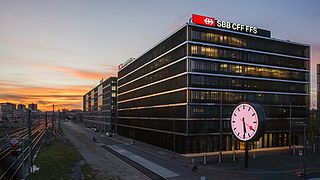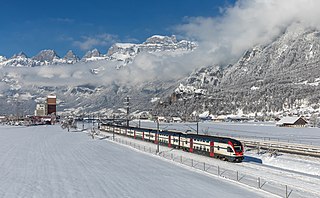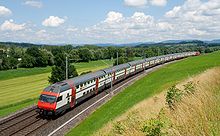
Swiss Federal Railways is the national railway company of Switzerland.

Rail transport in Switzerland is noteworthy for the density of its network, its coordination between services, its integration with other modes of transport, timeliness and a thriving domestic and trans-Alp freight system. It is made necessary by strong regulations on truck transport, and is enabled by properly coordinated intermodal logistics.
The InterRegio, often shortened to IR, is a train service in use in some European countries with Swiss Federal Railways operating the most dense network. InterRegio trains are semi-fast long-distance trains with more stops and usually lower prices than more upscale long-distance trains such as the InterCity.

InterCity is the classification applied to certain long-distance passenger train services in Europe. Such trains generally call at major stations only.

Geneva railway station, also known as Geneva Cornavin railway station, is Geneva's main train station, located in the centre of the city. The immediate area surrounding it is known as Cornavin; both names can be used interchangeably.

The Double-deck Coach is a bilevel passenger railcar currently manufactured by Alstom, which acquired Bombardier Transportation in 2021 used by various European railways and Israel Railways. The current generation of double-deck coaches can be run at speeds up to 200 km/h (125 mph). Depending on their configuration, each coach can seat 100 to 150 passengers.

The Olten–Bern railway line is one of the major railway lines of Switzerland, running between the major rail hub of Olten—where lines from Zürich, Basel, Bern, Lucerne and Neuchâtel come together—and the Swiss capital of Bern. Together with the Lausanne–Bern railway, it forms the Mittellandlinie, which connects Olten with Lausanne. The first part of the line was opened in 1856 and the original line was completed on 4 September 1858. The line was built by the Swiss Central Railway, which was taken over by the Swiss Federal Railways on its establishment in 1902.

Olten railway station is a major hub railway station in the canton of Solothurn, Switzerland, at the junction of lines to Zürich, Bern, Basel, Lucerne and Biel. As a result, Olten is a railway town and was also the site of the main workshop of the Swiss Central Railway, which became a major workshop for the Swiss Federal Railways (SBB CFF FFS). It is the southern terminus of the Basel Regional S-Bahn S3 and S9 lines, the northern terminus of the Lucerne S-Bahn S8 line, and the western terminus of the Aargau S-Bahn S26 line.

The Südostbahn – commonly abbreviated to SOB – is a Swiss railway company, and a 1,435 mmstandard gauge network in Central and Eastern Switzerland. It resulted from the merger of the original SOB with the Bodensee–Toggenburg railway (BT) at the end of 2001.

Rail 2000 is a large-scale project of the Swiss Federal Railways (SBB CFF FFS) established in 1987 to improve the quality of the Swiss rail network for the New millennium. It includes measures to accelerate a number of existing connections and the modernisation of rolling stock. The federal government decision to support the project in 1986 was approved by a referendum in 1987. In 2004 the first phase was completed consisting of around 130 projects with a budget of around CHF 5.9 billion.

Lausanne railway station is the main intercity and regional railway station for the city of Lausanne, Vaud, Switzerland. It is often known as Lausanne CFF to distinguish it from others in the town.

Geneva Airport railway station is a train station located underground next to the terminal building of Geneva International Airport, in Grand-Saconnex, Geneva, Switzerland. It is located at the end of the standard gauge Lausanne–Geneva line of Swiss Federal Railways.

Zurich Airport railway station is a railway station serving Zurich Airport in Switzerland. The station is located underneath the Airport Centre, the main ground-side passenger terminal of the airport, which is in the canton of Zurich and the municipality of Kloten.

Biel/Bienne railway station serves the bilingual municipality of Biel/Bienne, in the canton of Bern, Switzerland.

Neuchâtel railway station serves the municipality of Neuchâtel, the capital city of the canton of Neuchâtel, Switzerland. Opened in 1857, it is owned and operated by SBB-CFF-FFS.

The Aargau S-Bahn is an S-Bahn-style regional rail network serving the canton of Aargau, Switzerland, with some services extending into the cantons of Bern, Lucerne, Solothurn and Zug and one service to the German city of Waldshut-Tiengen.

The Biel/Bienne–Bern railway is a railway line in Switzerland and connects the city of Biel/Bienne with Bern. The line is owned by Swiss Federal Railways (SBB), long-distance services are operated by the SBB, and regional services are operated by the BLS.

The Ziegelbrücke–Sargans railway line is a railway line in the Swiss cantons of St. Gallen and Glarus owned by Swiss Federal Railways (SBB) and operated by services of SBB, SOB, ÖBB and DB. It connects Ziegelbrücke with Sargans via Lake Walen and the Seez Valley.

Langenthal railway station is a railway station in the municipality of Langenthal, in the Swiss canton of Bern. It is located at the junction of the standard gauge Langenthal–Huttwil line of BLS AG and Olten–Bern line of Swiss Federal Railways. The station is also the junction of the 1,000 mm gauge Langenthal–Oensingen and Langenthal–Melchnau lines of Aare Seeland mobil.

The InterCity, abbreviated IC, are mainline trains in Switzerland connecting the country's major agglomerations, the range of services of which is located between InterRegio (IR) (inter-regional) and EuroCity (EC). These trains are generally equipped with air-conditioned equipment, a CFF restaurant or a CFF bistro, a mini-bar service, a quiet area and a business area in 1st class as well as a family area or, occasionally, a family car in 2nd class.






















